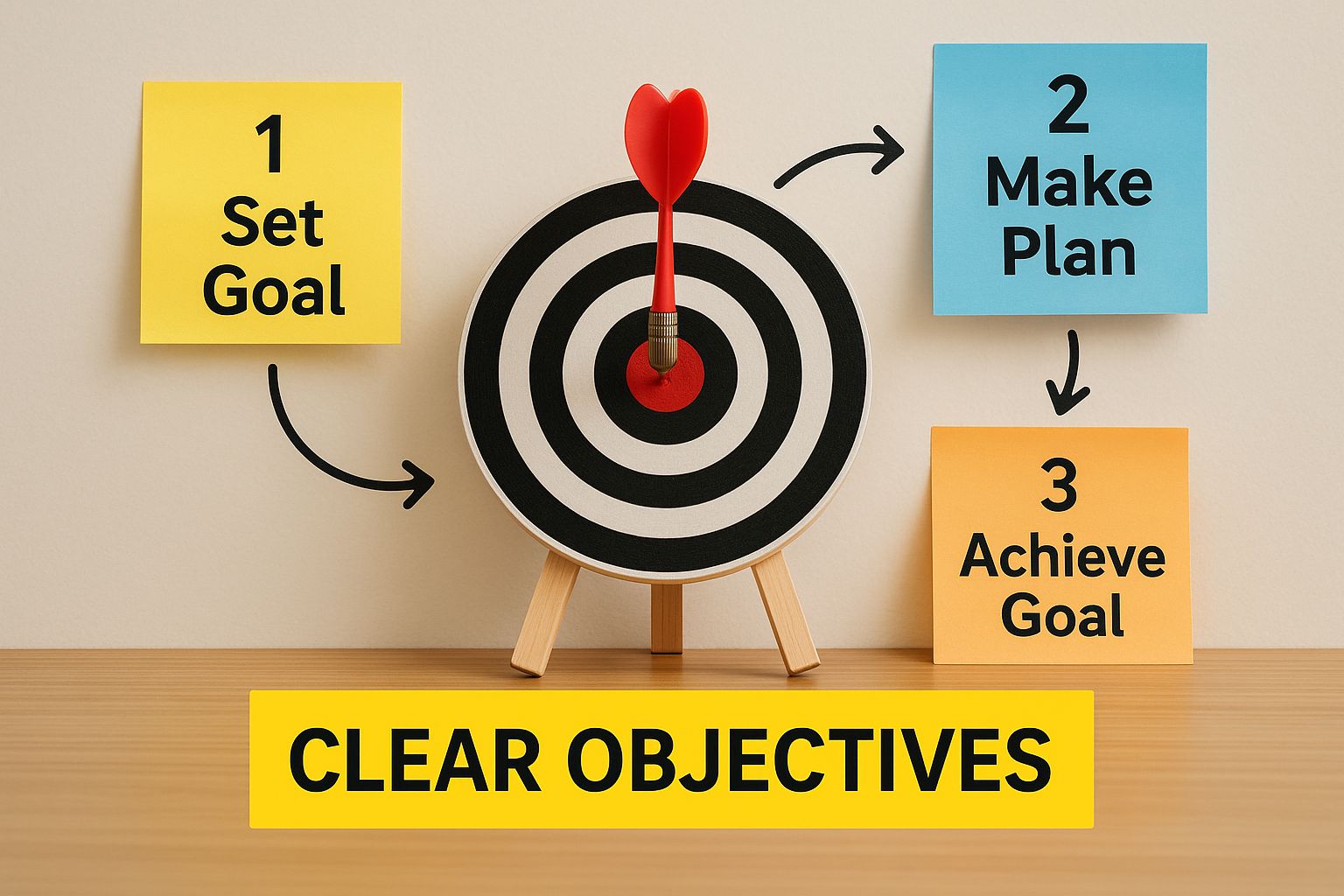A stakeholder communication plan is the strategic document that lays out who gets what information, when they get it, and how you’ll deliver it. Don’t think of it as just more paperwork. It’s your project’s insurance policy against the classic pitfalls of human error, crossed wires, and mismatched expectations.
Why a Communication Plan Is Your Project’s Lifeline

So many projects fail because of poor communication, not technical problems. When stakeholders are either left in the dark or—just as bad—flooded with updates that don’t matter to them, the outcome is almost always the same. Scope creep, busted budgets, and fading support. A solid communication plan turns that potential chaos into clarity and builds a foundation of trust.
Think about a new software feature launch. Without a plan, marketing might have no idea about a crucial last-minute change. An executive sponsor could miss the one progress report they needed for a board meeting. The customer support team? They’re completely blindsided by user complaints on day one. Everyone is working in their own little bubble, and the project is teetering on the edge.
The Real Cost of Miscommunication
The fallout from poor communication isn’t just theoretical; it’s tangible. It fosters an environment where stress and burnout run rampant, directly hurting team performance and project results. In fact, poor workplace communication is a key factor for 43% of people who report feeling burnout and stress. If that doesn’t highlight a massive business challenge, I don’t know what does. You can dig into more communication statistics to see the full, sobering picture.
Even with all the modern tools at our fingertips, communication often breaks down because teams fall into the trap of using just one channel for everything.
The biggest mistake is assuming everyone consumes information the same way. A detailed email that’s perfect for one stakeholder group becomes instant noise for another. A solid plan moves you from broadcasting information to targeted, purposeful engagement.
Building Alignment and Managing Expectations
A well-crafted plan does more than just push information out; it actively manages everyone’s expectations. It forces you to sit down and figure out what “success” actually means to each stakeholder, then tailor your updates to match. This simple act can prevent that dreaded “I thought we were building…” conversation from ever happening late in the project.
Your plan needs to clearly define a few key things:
- Key Messages: What is the core information each group absolutely needs to know?
- Communication Channels: Is a formal report the right call, or would a quick chat message or a dashboard update be more effective for this person?
- Frequency: How often does each stakeholder need an update? Think in terms of daily, weekly, or only at major milestones.
- Owner: Who is on the hook for preparing and sending each communication?
By mapping all this out, you create a reliable, predictable rhythm of updates. It keeps everyone on the same page, from the dev team right up to the C-suite. It’s the difference between steering a ship with a clear map and just hoping you drift in the right direction.
How to Map and Understand Your Stakeholders
Before you can dream of writing a communication plan, you have to know exactly who you’re talking to. This isn’t about just making a list of names. It’s about truly understanding what makes each person tick—their motivations, their influence, and what they expect from you and your project.
Skipping this foundational step is like setting off on a road trip without a map. Sure, you’re moving, but you have no idea if you’re heading in the right direction.
Let’s take a classic example: rolling out new CRM software across the company. The list of stakeholders is long and varied. You have the C-suite sponsors who signed off on the budget, the IT team handling the technical lift, sales managers whose teams will live in the software daily, and the customer service reps who need accurate data from it. Each one has a completely different perspective and stake in the outcome.
The image below really drives this point home. It shows how clear objectives, which come directly from understanding your stakeholders’ needs, are the absolute core of any successful project.

This visual makes it clear: if you don’t define what each stakeholder group needs to achieve first, your communication efforts will be scattered and ultimately, ineffective.
Using a Power and Interest Grid
So, how do you get this clarity? One of the most practical tools I’ve used time and again is the power/interest grid. It’s a straightforward matrix that helps you categorize stakeholders so you can stop treating everyone the same and start focusing your energy where it counts.
The grid plots each stakeholder’s level of interest in the project against their level of power or influence over it. This isn’t just a theoretical exercise; it has immediate, practical implications.
To illustrate how to use a power/interest grid, let’s create a Stakeholder Analysis Matrix for our CRM rollout example. This table helps organize your thoughts and ensures you’re not missing key details for each group.
Stakeholder Analysis Matrix Example
| Stakeholder Group | Interest Level (Low/High) | Influence Level (Low/High) | Key Expectations | Primary Communication Goal |
|---|---|---|---|---|
| Executive Sponsor | High | High | ROI, on-time delivery, clear progress reports | Manage Closely: Keep them deeply engaged with regular, detailed updates. Their support is critical. |
| Head of Legal | Low | High | Data compliance, security protocols are met | Keep Satisfied: Consult on key legal milestones; no need for daily updates. |
| Sales Reps (End-Users) | High | Low | Easy to use, saves time, improves their commissions | Keep Informed: Provide practical training, clear instructions, and “what’s in it for me” messaging. |
| Uninvolved Departments | Low | Low | Minimal disruption to their own work | Monitor: Minimal effort required. A general company-wide announcement is sufficient. |
This simple categorization instantly clarifies where you need to invest your time and communication efforts. For a deeper dive into this process, you can find a lot more detail in this guide to building an effective stakeholder communication plan.
Digging Deeper Than Job Titles
Mapping stakeholders isn’t just about plotting them on a grid based on their title. You need to get to the heart of their motivations. What do they really care about? Why should they support your project?
A one-size-fits-all communication plan is doomed from the start. We have to account for how different groups consume information. For instance, the workforce is more varied than ever, split between desk-based (51%), non-desk (26%), and hybrid (23%) employees. Each of these groups has completely different communication needs and preferences.
A stakeholder map is a living document. People’s influence and interest can change as the project progresses. Revisit it at key milestones to ensure your communication strategy remains aligned and effective.
Once you’ve done this groundwork, you’re no longer just sending out generic updates into the void. You’re creating a targeted, strategic plan that addresses specific concerns, delivers the right information to the right people, and builds the momentum you need for success. You can see how this translates into real-world documents by exploring a variety of https://www.resolution.de/post/internal-communication-plan-examples/. This foundational work is what transforms your plan from a simple document into a powerful tool.
Setting Clear Goals and Crafting Your Message

Alright, you’ve mapped out who your stakeholders are. The next step is a big one: figuring out what you actually want to accomplish with your communication. I’ve seen too many plans fail because the goals were fuzzy. Vague objectives like “keeping everyone in the loop” just create noise, not impact.
An effective communication plan starts with sharp, measurable goals. Instead of just “updating the executive team,” a much better goal is “securing final budget approval from the steering committee by the end of Q2.” See the difference? One is a passive report; the other is a strategic action designed to get a specific result.
From Vague Ideas to Concrete Goals
To build a solid foundation, you have to connect your communication directly to business outcomes. The trick I’ve learned is to ask what you need each stakeholder group to know, feel, and do after hearing from you.
Let’s imagine you’re launching new internal software:
- The Goal: Drive adoption and slash the number of support tickets.
- The “Know”: End-users need to understand how this new tool saves them time and where to find the training guides.
- The “Feel”: They should feel confident and supported, not overwhelmed by a change that was forced on them.
- The “Do”: They must complete the required training and start using the software for their daily work.
This simple framework completely changes your perspective. You stop being a broadcaster of information and become a guide, actively shaping perceptions and behaviors to help your project succeed. When you define these outcomes first, crafting the right message becomes a whole lot easier.
A classic mistake is getting bogged down in the “what” of the project—the features, the timeline, the tech specs. Always start with the “why” for each stakeholder. Why should they care? What’s in it for them?
Crafting Messages That Resonate
Once you have clear goals for each stakeholder group, you can start tailoring your messages. This is where the real art comes in. The update you send to a deep-in-the-weeds IT manager will sound completely different from the one you send to a non-technical marketing lead, even if it’s about the exact same project milestone.
Think of it like creating soundbites. Your job is to distill complex project details into concise, relevant, and consistent messages that speak directly to each audience’s main concerns and motivations. This means translating technical progress into business value for executives, or framing a process change in terms of efficiency gains for an operations team.
This targeted approach ensures your messages don’t just get delivered—they get understood and acted upon. Getting teams aligned often means bridging gaps between different departments and systems. Clear communication is the glue that holds it all together. To see how powerful tool integrations can support this, check out how the HubSpot-Jira integration for aligning teams works. A well-crafted message closes those gaps and makes sure everyone is pulling in the same direction.
You’ve mapped your stakeholders and you know what you need to say. Now comes the real test: figuring out how and how often to actually talk to them. This is where the rubber meets the road, and a bad choice here can completely torpedo all your strategic work.
Think about it—sending the perfect message through the wrong channel is like shouting into a hurricane. It just gets lost.
The goal isn’t to just blast out information. It’s about delivering updates in a way that respects everyone’s time and how they prefer to get their news. This is how you avoid “update fatigue,” a very real problem where people just start tuning you out because they’re buried in notifications.
Matching the Channel to the Stakeholder
It’s tempting to just default to email, but that’s a rookie mistake. Your communication channels need to be as varied as your stakeholders themselves.
Let’s go back to our software rollout example to see this in action:
- The Executive Sponsor: They don’t have time for the day-to-day chatter. A crisp, bi-weekly summary email highlighting progress against KPIs and flagging major risks is exactly what they need.
- The Core Project Team: They live and breathe this project. Real-time updates are a must. A dedicated Slack or MS Teams channel is perfect for quick questions, sorting out blockers, and celebrating small victories.
- Sales Reps (the End-Users): You need to win them over, so a mix of channels is best. Think a monthly newsletter with “what’s in it for me” tips, short video tutorials, and some hands-on training sessions to get them comfortable and excited.
- The Head of Legal: This stakeholder is a specialist. They only need to be involved for specific, formal reviews. A scheduled meeting with a report sent in advance is way more effective than a casual ping on Slack.
The real skill in building a communication plan isn’t just making a list of channels. It’s creating a matrix that precisely matches the channel, message, and frequency to each stakeholder group. It’s about surgical precision, not a shotgun blast.
Finding the Right Communication Rhythm
Just as crucial as the how is the when. The frequency of your updates sets a rhythm for the project. It creates a predictable, reliable flow of information that builds trust. Bombard people with too many updates, and it feels like micromanagement. Go silent for too long, and they’ll assume the project is dead in the water.
A simple schedule is your best friend here. This isn’t about being overly rigid, but about being intentional. When you document your communication cadence, you create a system that keeps you accountable and makes the whole process transparent. Any solid communication plan template will have a section dedicated to mapping this out.
This schedule becomes the backbone of your action plan, detailing every single touchpoint you intend to make.
To make this crystal clear, here’s a quick breakdown of how different channels align with different stakeholder needs and cadences.
Matching Communication Channels to Stakeholder Needs
Choosing the right tool for the job is everything. A town hall can’t replace a quick Slack message, and a detailed report shouldn’t be squeezed into an email. This table breaks down which channel to use for which purpose.
| Channel | Best For (Message Type) | Ideal Stakeholder | Pros | Cons |
|---|---|---|---|---|
| Email Summary | High-level progress, KPI updates, official announcements | Executives, Department Heads, External Partners | Asynchronous, formal record, good for filtered information | Easily ignored, can lack immediacy, not great for discussion |
| Instant Messaging | Quick questions, daily updates, informal collaboration | Internal Project Team, Cross-functional Peers | Real-time, promotes quick resolution, builds team cohesion | Can be distracting, information gets buried, not for formal decisions |
| Formal Report | Detailed analysis, milestone reviews, in-depth data | Steering Committee, Investors, Regulators | Comprehensive, provides evidence, creates official record | Time-consuming to create, can be dense and hard to digest |
| Town Hall Meeting | Major announcements, vision setting, morale boosting | All Company Employees, Large Departments | High-impact, allows for live Q&A, builds alignment | Logistically complex, hard to manage for large/remote groups |
| 1-on-1 Meeting | Sensitive feedback, strategic alignment, problem-solving | Key Influencers, Direct Reports, High-interest Stakeholders | Highly personal, allows for deep conversation, builds relationships | Time-intensive, not scalable for large groups |
Ultimately, selecting your channels and rhythm all boils down to empathy. Put yourself in your stakeholders’ shoes. What would be most helpful for them? When you design your plan with respect for their time and attention, your critical messages won’t just be sent—they’ll be received, understood, and acted upon.
Putting Your Communication Plan into Action
This is where the rubber meets the road. All your strategic work—mapping stakeholders, defining goals, and picking your channels—needs to come together into a single, living document. A solid communication plan is your project’s command center, detailing who gets what information, when they get it, and how.
But let’s be honest: a plan is useless if it just collects digital dust in a shared drive. Its real value comes from being put into motion, day in and day out. The goal is to move from a static document to a living, breathing part of your project’s daily rhythm.
From Document to Daily Practice
First things first: you need to assign clear ownership for every single communication task. That weekly executive email? Someone owns it. The daily team huddle? Someone runs it. This accountability is non-negotiable. It’s the only way to guarantee messages go out on time and nothing slips through the cracks.
A simple action plan or schedule is essential here. Think of it as the master calendar for all your project communications.
It should clearly lay out:
- The Communication: e.g., “Monthly Progress Report.”
- The Audience: e.g., “Executive Steering Committee.”
- The Owner: e.g., “Project Manager.”
- The Channel: e.g., “Email.”
- The Due Date: e.g., “First business day of each month.”
Juggling all these moving parts is where many plans fall apart. Keeping everything organized is crucial, and it often means utilizing versatile organization tools like Notion, which has some great templates for structuring project info and tracking communication activities.
Integrating Feedback Loops
A communication plan should never be set in stone. It’s got to be a dynamic tool that adapts to the project’s reality as it unfolds. The only way to do that effectively is by building in simple, consistent feedback loops. You have to know if your messages are actually landing.
Don’t just broadcast information; create pathways for dialogue. A great plan doesn’t just talk at stakeholders—it listens to them. This two-way flow is where you uncover hidden risks and build genuine trust.
For example, after a big update, send a quick poll asking recipients if the information was clear and helpful. For your core team, a brief “communications check-in” during a weekly meeting can surface issues immediately. Are people feeling swamped with updates? Is a particular channel being totally ignored? This feedback is gold.
This adaptability is even more critical when you’re operating globally. By 2025, it’s projected that nearly 50% of internet content will be in languages other than English. A one-size-fits-all approach just won’t cut it anymore. You can read the full research about these global communication trends to get a better sense of their impact.
Launching the Plan and Gaining Buy-In
When you’re ready to kick things off, make it a formal launch. Don’t just start firing off new reports and hope people notice. Announce the plan to all stakeholders, explaining the new communication rhythm and what they can expect. It sets a professional tone and manages expectations right from the start.
Getting your immediate team bought in is especially important. Walk them through the plan, explain the why behind it, and make sure their roles are crystal clear. When your team members see how their specific communication tasks help the project succeed, they become active partners, not just people checking off a to-do list.
Connecting your systems can also be a massive help here. Streamlining processes between platforms is key to keeping support and service teams aligned. For instance, you can learn more about the HubSpot-Jira integration for support teams to see how this works in a real-world scenario.
Common Questions About Stakeholder Communication Plans
Even the most seasoned project leaders run into questions when building a communication plan for stakeholders. This isn’t just about theory; it’s about navigating the real, often messy, human dynamics of a project. Answering these common queries head-on can help you sidestep pitfalls and get far better results from your efforts.
What’s the Biggest Mistake to Avoid?
The most common trap is creating a one-size-fits-all plan. It’s tempting to draft a single, generic update and blast it out to everyone on your list, but this approach almost always backfires.
This creates two massive problems. First, key decision-makers quickly learn to ignore your messages because they’re buried in irrelevant details. Second, other essential groups don’t get the specific information they actually need to do their jobs, which leads to widespread disengagement.
A successful plan is always built on solid stakeholder analysis, tailoring the message, channel, and frequency to each distinct group. It’s about communicating smarter, not just more often. This proactive approach ensures your communication is seen as a signal, not just noise.
How Should I Manage a Difficult Stakeholder?
Dealing with a resistant stakeholder requires strategy, not just more communication. Resistance often stems from a perceived risk to their personal or departmental interests. Your very first step should be to understand their “why.”
Schedule a one-on-one meeting with the express purpose of listening more than you talk. Acknowledge their concerns to show you’re hearing them, and try to find some common ground. From there, you can proactively provide them with the specific information they care about most, showing how the project addresses—or at least acknowledges—their worries. Consistent, transparent, and tailored communication can often turn a critic into an ally.
How Often Should I Update the Plan?
Think of your stakeholder communication plan as a living document, not a static file you create once and then forget about. It has to evolve right alongside your project.
You should formally review and update it at key project milestones, like at the end of a sprint or development phase. It’s also critical to revisit the plan anytime there’s a significant change in scope, timeline, or key personnel.
If you want a more detailed look at how to structure and maintain your plan, our complete guide to building a stakeholder communication plan offers additional insights. And remember, if you notice engagement dropping or misinformation spreading, that’s your cue to adapt.
Want to make your team meetings more effective and less chaotic? resolution Reichert Network Solutions GmbH introduces NASA – Not Another Standup App. It’s an agile meeting tool inside Jira that brings structure, clarity, and balanced participation to every discussion. Learn how NASA can transform your standups and sprint reviews at https://www.resolution.de/nasa.
